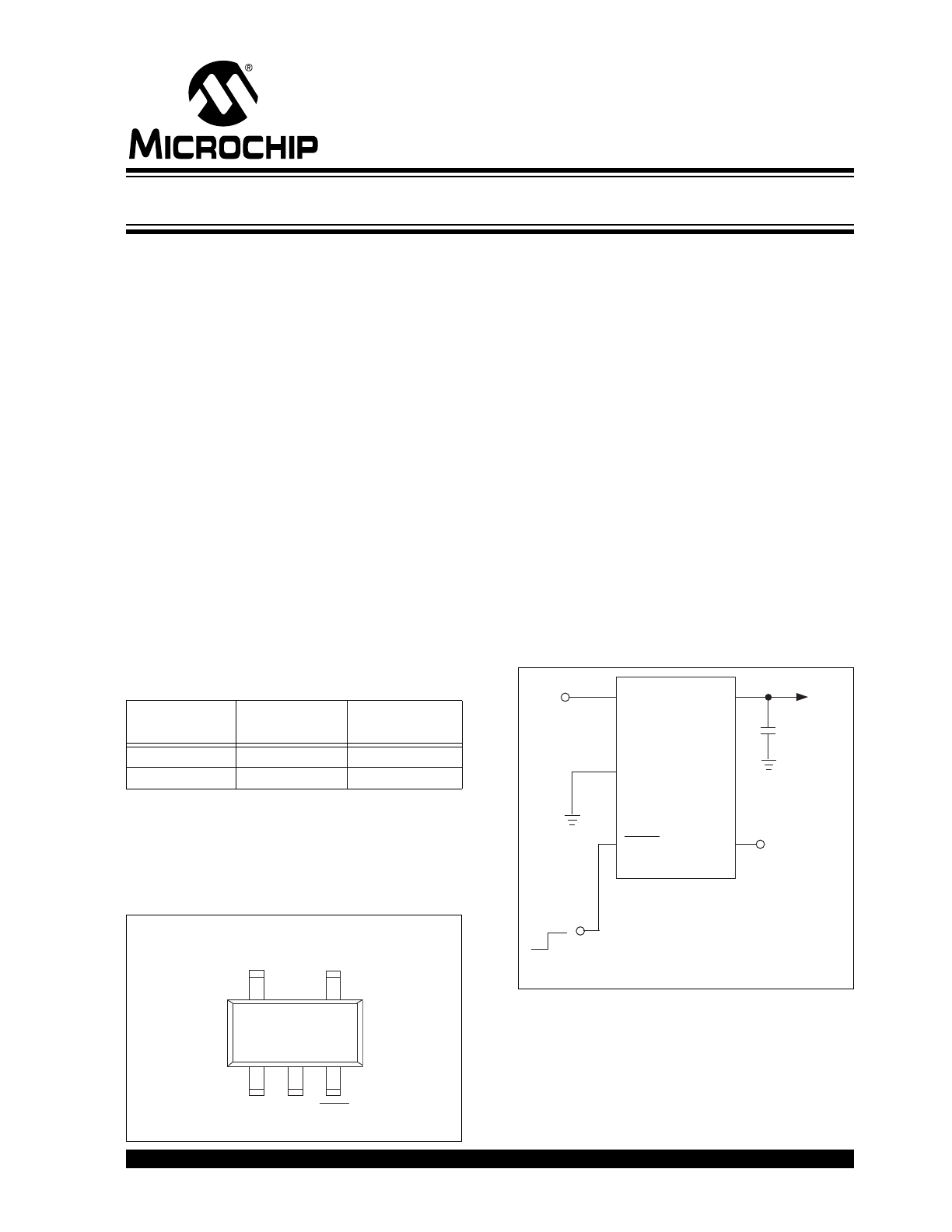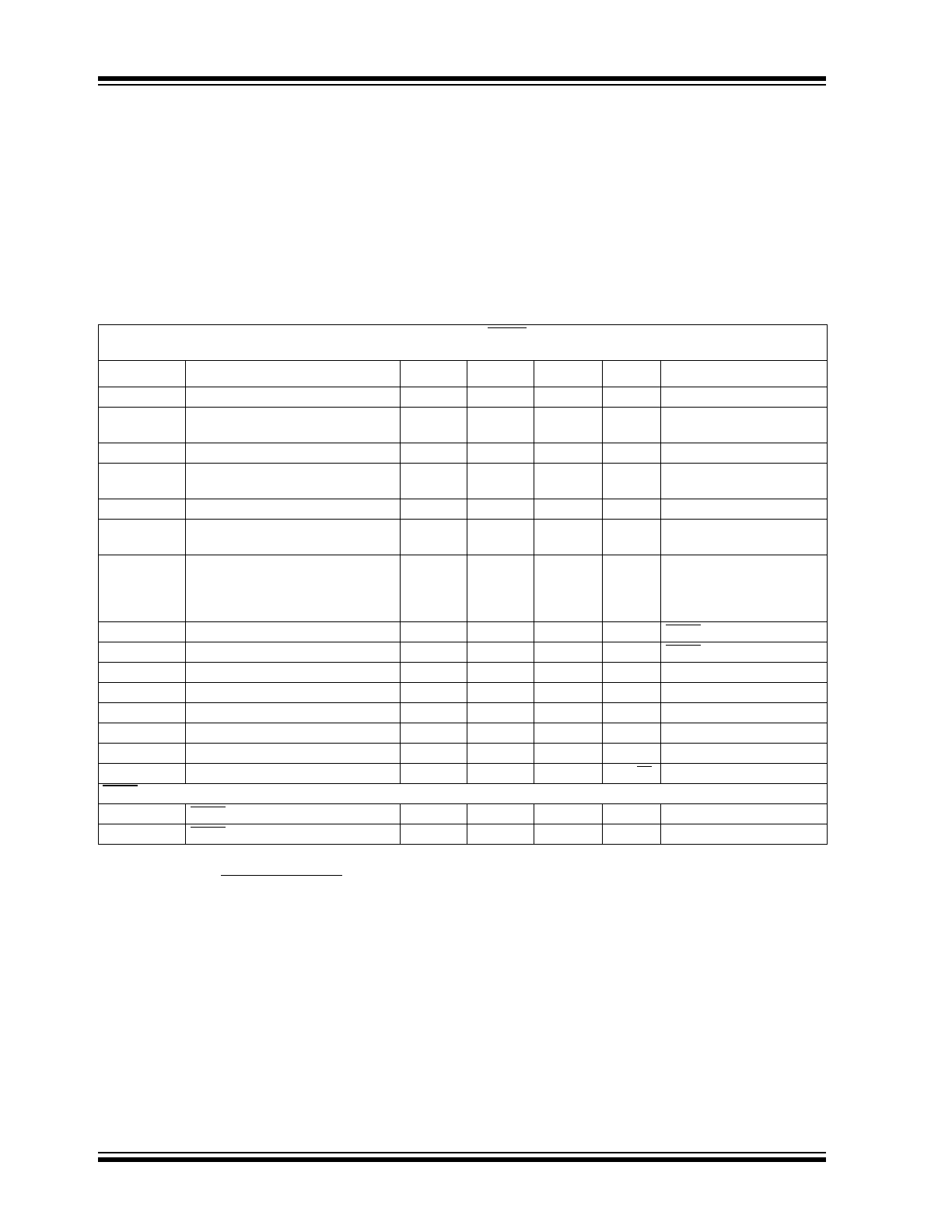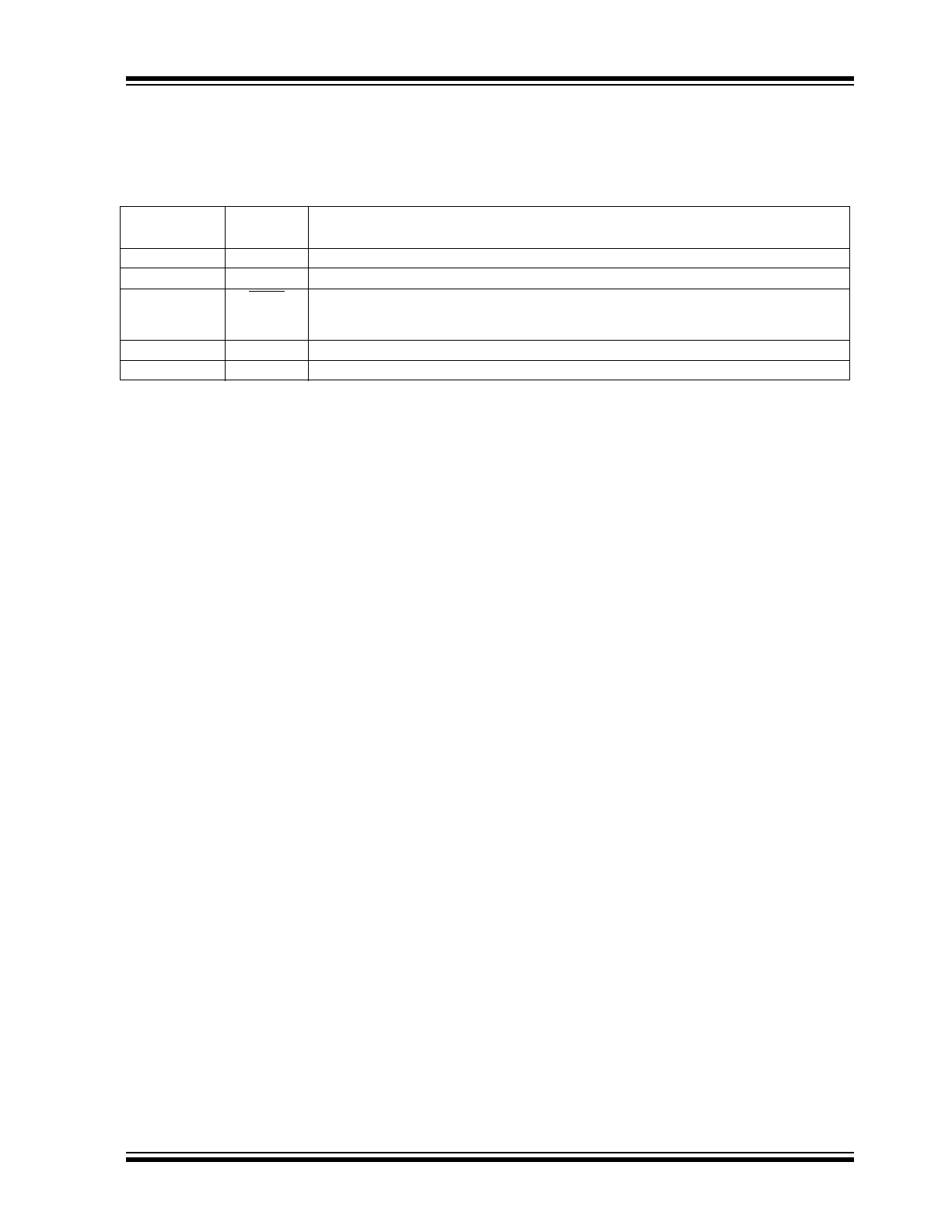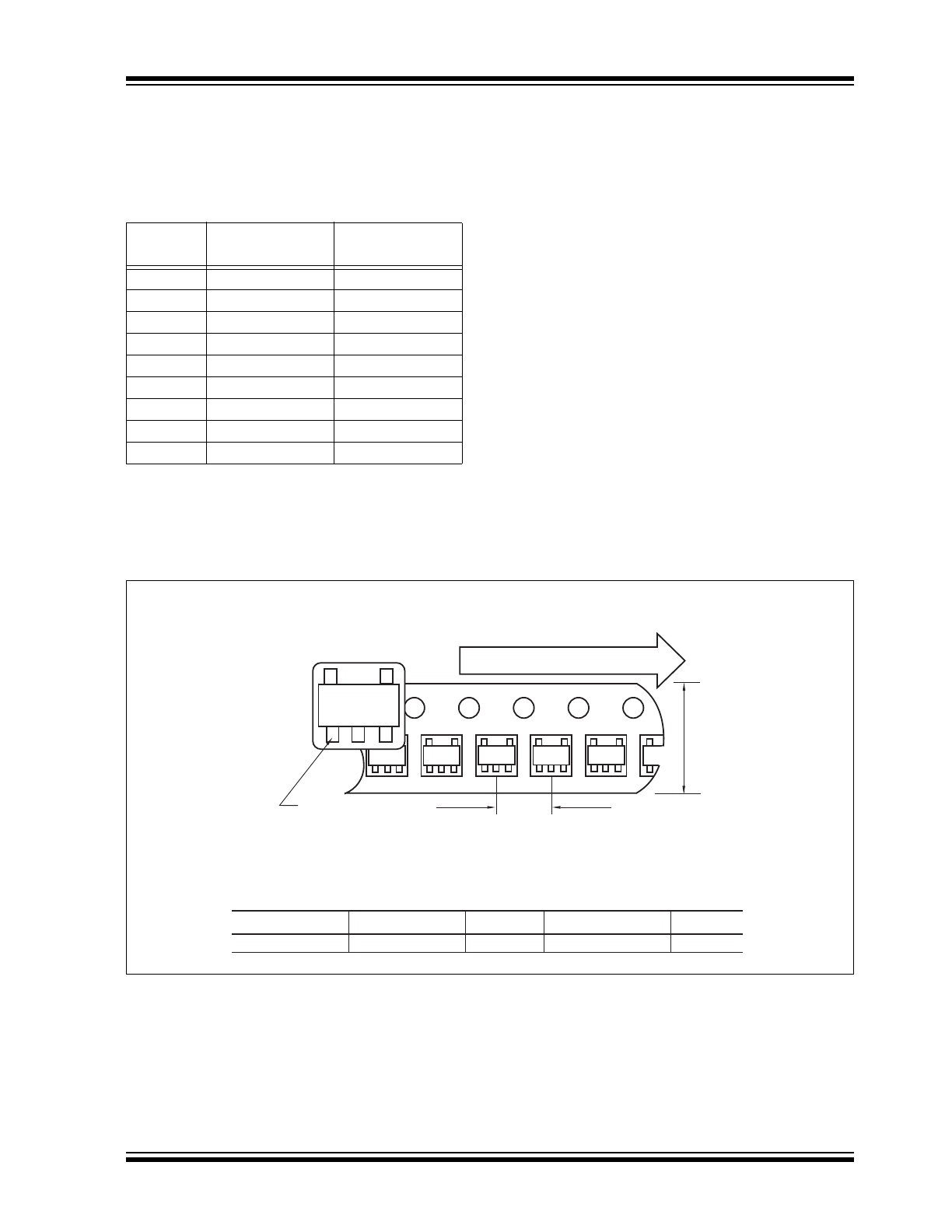
2002-2012 Microchip Technology Inc.
DS21368C-page 1
TC1223/TC1224
Features
• Extremely Low Ground Current for Longer Battery
Life
• Very Low Dropout Voltage
• Choice of 50mA and 100mA Output (TC1223,
TC1224, Respectively)
• High Output Voltage Accuracy
• Standard or Custom Output Voltages
• Power Saving Shutdown Mode
• Over Current and Over Temperature Protection
• Space-Saving 5-Pin SOT-23A Package
• Pin Compatible Upgrades for Bipolar Regulators
Applications
• Battery Operated Systems
• Portable Computers
• Medical Instruments
• Instrumentation
• Cellular/GSM/PHS Phones
• Linear Post-Regulators for SMPS
• Pagers
Device Selection Table
NOTE: xx indicates output voltages
Available Output Voltages: 2.5, 2.7, 2.8, 2.85, 3.0, 3.3, 3.6,
4.0, 5.0.
Other output voltages are available. Please contact Microchip
Technology Inc. for details.
Package Type
General Description
The TC1223 and TC1224 are high accuracy (typically
±0.5%) CMOS upgrades for older (bipolar) low dropout
regulators such as the LP2980. Designed specifically
for battery-operated systems, the devices’ CMOS
construction eliminates wasted ground current,
significantly extending battery life. Total supply current
is typically 50
A at full load (20 to 60 times lower than
in bipolar regulators).
The devices’ key features include ultra low noise
operation; very low dropout voltage (typically 85mV,
TC1223 and 180mV, TC1224 at full load) and fast
response to step changes in load. Supply current is
reduced to 0.5
A (max) and V
OUT
falls to zero when
the shutdown input is low. The devices incorporate both
over temperature and over current protection.
The TC1223 and TC1224 are stable with an output
capacitor of only 1
F and have a maximum output
current of 50mA and 100mA respectively. For higher
output current versions, please see the TC1107,
TC1108 and TC1173 (I
OUT
= 300mA) data sheets.
Typical Application
Part Number
Package
Junction
Temp. Range
TC1223-xxVCT
5-Pin SOT-23A
-40°C to +125°C
TC1224-xxVCT
5-Pin SOT-23A
-40°C to +125°C
5-Pin SOT-23A
SHDN
5
TC1223
TC1224
1
3
4
2
V
IN
V
OUT
GND
NC
NOTE: 5-Pin SOT-23A is equivalent to the EIAJ (SC-74A)
TC1223
TC1224
V
OUT
SHDN
GND
NC
1
μF
+
V
IN
V
IN
V
OUT
1
5
2
4
3
Shutdown Control
(from Power Control Logic)
50mA and 100mA CMOS LDOs with Shutdown

TC1223/TC1224
DS21368C-page 2
2002-2012 Microchip Technology Inc.
1.0
ELECTRICAL SPECIFICATIONS
Absolute Maximum Ratings*
Input Voltage .........................................................6.5V
Output Voltage........................... (-0.3V) to (V
IN
+ 0.3V)
Power Dissipation.............................. Internally Limited
Maximum Voltage on Any Pin ........ V
IN
+0.3V to -0.3V
Operating Temperature Range...... -40°C < T
J
< 125°C
Storage Temperature..........................-65°C to +150°C
Stresses above those listed under "Absolute Maximum
Ratings" may cause permanent damage to the device. These
are stress ratings only and functional operation of the device
at these or any other conditions above those indicated in the
operation sections of the specifications is not implied.
Exposure to Absolute Maximum Rating conditions for
extended periods may affect device reliability.
TC1223/TC1224 ELECTRICAL SPECIFICATIONS
Electrical Characteristics: V
IN
= V
OUT
+ 1V, I
L
= 100
A, C
L
= 3.3
F, SHDN > V
IH
, T
A
= 25°C, unless otherwise noted. Boldface
type specifications apply for junction temperatures of -40°C to +125°C.
Symbol
Parameter
Min
Typ
Max
Units
Test Conditions
V
IN
Input Operating Voltage
2.7
—
6.0
V
Note 8
I
OUT
MAX
Maximum Output Current
50
100
—
—
—
—
mA
TC1223
TC1224
V
OUT
Output Voltage
V
R
– 2.5% V
R
±0.5%
V
R
+ 2.5%
V
Note 1
TCV
OUT
V
OUT
Temperature Coefficient
—
—
20
40
—
—
ppm/°C
Note 2
V
OUT
/
V
IN
Line Regulation
—
0.05
0.35
%
(V
R
+ 1V)
V
IN
6V
V
OUT
/V
OUT
Load Regulation
—
0.5
2
%
I
L
= 0.1mA to I
OUT
MAX
(Note 3)
V
IN
-V
OUT
Dropout Voltage
TC1224
—
—
—
—
2
65
85
180
—
—
120
250
mV
I
L
= 100
A
I
L
= 20mA
I
L
= 50mA
I
L
= 100mA (Note 4)
I
IN
Supply Current
—
50
80
A
SHDN = V
IH
, I
L
= 0 (Note 7)
I
INSD
Shutdown Supply Current
—
0.05
0.5
A
SHDN = 0V
PSRR
Power Supply Rejection Ratio
—
64
—
dB
F
RE
1kHz
I
OUT
SC
Output Short Circuit Current
—
300
450
mA
V
OUT
= 0V
V
OUT
/
P
D
Thermal Regulation
—
0.04
—
V/W
Notes 5, 6
T
SD
Thermal Shutdown Die Temperature
—
160
—
°C
T
SD
Thermal Shutdown Hysteresis
—
10
—
°C
eN
Output Noise
—
260
—
nV/
Hz I
L
= I
OUT
MAX
SHDN Input
V
IH
SHDN Input High Threshold
45
—
—
%V
IN
V
IN
= 2.5V to 6.5V
V
IL
SHDN Input Low Threshold
—
—
15
%V
IN
V
IN
= 2.5V to 6.5V
Note
1:
V
R
is the regulator output voltage setting. For example: V
R
= 2.5V, 2.7V, 2.85V, 3.0V, 3.3V, 3.6V, 4.0V, 5.0V.
2:
3:
Regulation is measured at a constant junction temperature using low duty cycle pulse testing. Load regulation is tested over a load range
from 0.1mA to the maximum specified output current. Changes in output voltage due to heating effects are covered by the thermal
regulation specification.
4:
Dropout voltage is defined as the input to output differential at which the output voltage drops 2% below its nominal value at a 1V
differential.
5:
Thermal Regulation is defined as the change in output voltage at a time T after a change in power dissipation is applied, excluding load or
line regulation effects. Specifications are for a current pulse equal to I
LMAX
at V
IN
= 6V for T = 10 msec.
6:
The maximum allowable power dissipation is a function of ambient temperature, the maximum allowable junction temperature and the
thermal resistance from junction-to-air (i.e., T
A
, T
J
,
JA
). Exceeding the maximum allowable power dissipation causes the device to initiate
thermal shutdown. Please see Section 4.0 Thermal Considerations for more details.
7:
Apply for Junction Temperatures of -40°C to +85°C.
8:
The minimum V
IN
has to justify the conditions: V
IN
V
R
+ V
DROPOUT
and V
IN
2.7V for I
L
= 0.1mA to I
OUT
MAX
.
TC V
OUT
= (V
OUT
MAX
– V
OUT
MIN
) x 10
6
V
OUT
x
T

2002-2012 Microchip Technology Inc.
DS21368C-page 3
TC1223/TC1224
2.0
PIN DESCRIPTIONS
The descriptions of the pins are listed in Table 2-1.
TABLE 2-1:
PIN FUNCTION TABLE
Pin No.
(5-Pin SOT-23A)
Symbol
Description
1
V
IN
Unregulated supply input.
2
GND
Ground terminal.
3
SHDN
Shutdown control input. The regulator is fully enabled when a logic high is applied to this input.
The regulator enters shutdown when a logic low is applied to this input. During shutdown, output
voltage falls to zero and supply current is reduced to 0.5
A (max).
4
NC
No connect.
5
V
OUT
Regulated voltage output.

TC1223/TC1224
DS21368C-page 4
2002-2012 Microchip Technology Inc.
3.0
DETAILED DESCRIPTION
The TC1223 and TC1224 are precision fixed output
voltage regulators. Unlike bipolar regulators, the
TC1223 and TC1224’s supply current does not
increase with load current. In addition, V
OUT
remains
stable and within regulation over the entire 0mA to
I
OUT
MAX
operating load current range, (an important
consideration in RTC and CMOS RAM battery back-up
applications).
Figure 3-1 shows a typical application circuit. The
regulator is enabled any time the shutdown input
(SHDN) is at or above V
IH
, and shutdown (disabled)
when SHDN is at or below V
IL
. SHDN may be
controlled by a CMOS logic gate, or I/O port of a micro-
controller. If the SHDN input is not required, it should be
connected directly to the input supply. While in
shutdown, supply current decreases to 0.05
A (typical)
and V
OUT
falls to zero volts.
FIGURE 3-1:
TYPICAL APPLICATION
CIRCUIT
3.1
Output Capacitor
A 1
F (min) capacitor from V
OUT
to ground is
recommended. The output capacitor should have an
effective series resistance greater than 0.1
and less
than 5.0
, and a resonant frequency above 1MHz. A
1
F capacitor should be connected from V
IN
to GND if
there is more than 10 inches of wire between the
regulator and the AC filter capacitor, or if a battery is
used as the power source. Aluminum electrolytic or
tantalum capacitor types can be used. (Since many
aluminum electrolytic capacitors freeze at approxi-
mately -30°C, solid tantalums are recommended for
applications operating below -25°C.) When operating
from sources other than batteries, supply-noise
rejection and transient response can be improved by
increasing the value of the input and output capacitors
and employing passive filtering techniques.
TC1223
TC1224
V
OUT
SHDN
GND
NC
1
μF
+
V
IN
V
OUT
Shutdown Control
(to CMOS Logic or Tie
to V
IN
if unused)
1
μF
+
Battery
+

2002-2012 Microchip Technology Inc.
DS21368C-page 5
TC1223/TC1224
4.0
THERMAL CONSIDERATIONS
4.1
Thermal Shutdown
Integrated thermal protection circuitry shuts the
regulator off when die temperature exceeds 160°C.
The regulator remains off until the die temperature
drops to approximately 150°C.
4.2
Power Dissipation
The amount of power the regulator dissipates is
primarily a function of input and output voltage, and
output current. The following equation is used to
calculate worst case actual power dissipation:
EQUATION 4-1:
The maximum allowable power dissipation (Equation
4-2) is a function of the maximum ambient temperature
(T
A
MAX
), the maximum allowable die temperature
(T
J
MAX
) and the thermal resistance from junction-to-air
(
JA
). The 5-Pin SOT-23A package has a
JA
of
approximately 220°C/Watt.
EQUATION 4-2:
Equation 4-1 can be used in conjunction with Equation
4-2 to ensure regulator thermal operation is within
limits. For example:
Given:
V
IN
MAX
= 3.0V ±10%
V
OUT
MIN
= 2.7V – 2.5%
I
LOAD
MAX
= 40mA
T
J
MAX
= 125°C
T
A
MAX
= 55°C
Find: 1. Actual power dissipation
2. Maximum allowable dissipation
Actual power dissipation:
P
D
(V
IN
MAX
– V
OUT
MIN
)I
LOAD
MAX
= [(3.0 x 1.1) – (2.7 x .975)]40 x 10
–3
= 26.7mW
Maximum allowable power dissipation:
In this example, the TC1223 dissipates a maximum of
26.7mW; below the allowable limit of 318mW. In a
similar manner, Equation 4-1 and Equation 4-2 can be
used to calculate maximum current and/or input
voltage limits.
4.3
Layout Considerations
The primary path of heat conduction out of the package
is via the package leads. Therefore, layouts having a
ground plane, wide traces at the pads, and wide power
supply bus lines combine to lower
JA
and therefore
increase the maximum allowable power dissipation
limit.
Where:
P
D
(V
IN
MAX
– V
OUT
MIN
)I
LOAD
MAX
P
D
V
IN
MAX
V
OUT
MIN
I
LOAD
MAX
= Worst case actual power dissipation
= Minimum regulator output voltage
= Maximum output (load) current
= Maximum voltage on V
IN
P
D
MAX
= (T
J
MAX
– T
A
MAX
)
JA
Where all terms are previously defined.
P
D
MAX
= (T
J
MAX
– T
A
MAX
)
JA
= (125 – 55)
220
= 318mW

TC1223/TC1224
DS21368C-page 6
2002-2012 Microchip Technology Inc.
5.0
TYPICAL CHARACTERISTICS
(Unless Otherwise Specified, All Parts Are Measured At Temperature = 25°C)
Note:
The graphs and tables provided following this note are a statistical summary based on a limited number of
samples and are provided for informational purposes only. The performance characteristics listed herein are
not tested or guaranteed. In some graphs or tables, the data presented may be outside the specified
operating range (e.g., outside specified power supply range) and therefore outside the warranted range.
0.000
0.002
0.004
0.006
0.008
0.010
0.012
0.014
0.016
0.018
0.020
-40
-20
0
20
50
70
125
DROPOUT VOLTAGE (V)
I
LOAD
= 10mA
C
IN
= 1
μF
C
OUT
= 1
μF
TEMPERATURE (
°C)
Dropout Voltage vs. Temperature (V
OUT
= 3.3V)
0.000
0.020
0.040
0.060
0.080
0.100
0.120
0.140
0.160
0.180
0.200
-40
-20
0
20
50
70
125
DROPOUT VOLTAGE (V)
I
LOAD
= 100mA
C
IN
= 1
μF
C
OUT
= 1
μF
TEMPERATURE (
°C)
Dropout Voltage vs. Temperature (V
OUT
= 3.3V)
0
10
20
30
40
50
60
70
80
90
GND CURRENT (
μ
A)
0 0.5 1 1.5 2 2.5 3 3.5 4 4.5 5 5.5 6 6.5 7 7.5
I
LOAD
= 100mA
C
IN
= 1
μF
C
OUT
= 1
μF
Ground Current vs. V
IN
(V
OUT
= 3.3V)
V
IN
(V)
0.000
0.010
0.020
0.030
0.040
0.050
0.060
0.070
0.080
0.090
0.100
-40
-20
0
20
50
70
125
DROPOUT VOLTAGE (V)
I
LOAD
= 50mA
C
IN
= 1
μF
C
OUT
= 1
μF
TEMPERATURE (
°C)
Dropout Voltage vs. Temperature (V
OUT
= 3.3V)
0
10
20
30
40
50
60
70
80
90
GND CURRENT (
μ
A)
0 0.5 1 1.5 2 2.5 3 3.5 4 4.5 5 5.5 6 6.5 7 7.5
I
LOAD
= 10mA
C
IN
= 1
μF
C
OUT
= 1
μF
Ground Current vs. V
IN
(V
OUT
= 3.3V)
V
IN
(V)
0
0.5
1
1.5
2
2.5
3
3.5
0 0.5 1 1.5 2 2.5 3 3.5 4 4.5 5 5.5 6 6.5 7
I
LOAD
= 0
C
IN
= 1
μF
C
OUT
= 1
μF
V
IN
(V)
V
OUT
(V)
V
OUT
vs.
V
IN
(V
OUT
= 3.3V)

2002-2012 Microchip Technology Inc.
DS21368C-page 7
TC1223/TC1224
5.0
TYPICAL CHARACTERISTICS (CONTINUED)
(Unless Otherwise Specified, All Parts Are Measured At Temperature = 25°C)
0.0
0.5
1.0
1.5
2.0
2.5
3.0
3.5
I
LOAD
= 100mA
C
IN
= 1
μF
C
OUT
= 1
μF
0 0.5 1 1.5 2 2.5 3 3.5 4 4.5 5 5.5 6 6.5 7
V
IN
(V)
V
OUT
(V)
V
OUT
vs.
V
IN
(V
OUT
= 3.3V)
4.985
4.990
4.995
5.000
5.005
5.010
5.015
5.020
5.025
-40
-20
-10
0
20
40
85
125
I
LOAD
= 10mA
V
IN
= 6V
C
IN
= 1
μF
C
OUT
= 1
μF
TEMPERATURE (
°C)
Output Voltage vs. Temperature (V
OUT
= 5V)
V
OUT
(V)
3.275
3.280
3.285
3.290
3.295
3.300
3.305
3.310
3.315
3.320
-40
-20
-10
0
20
40
85
125
I
LOAD
= 10mA
C
IN
= 1
μF
C
OUT
= 1
μF
V
IN
= 4.3V
TEMPERATURE (
°C)
V
OUT
(V)
Output Voltage vs. Temperature (V
OUT
= 3.3V)
0
10
20
30
40
50
60
70
-40
-20
-10
0
20
40
85
125
GND CURRENT (
μ
A)
I
LOAD
= 10mA
V
IN
= 6V
C
IN
= 1
μF
C
OUT
= 1
μF
TEMPERATURE (
°C)
Temperature
vs. Quiescent Current (V
OUT
= 5V)
10.0
1.0
0.1
0.0
0.01K 0.1K
1K
10K
100K
1000K
FREQUENCY (Hz)
Output Noise vs. Frequency
NOISE (
μ
V/
√
Hz)
R
LOAD
= 50
Ω
C
OUT
= 1
μF
C
IN
= 1
μF
1000
100
10
1
0.1
0.01
0 10 20 30 40 50 60 70 80 90 100
LOAD CURRENT (mA)
Stability Region vs. Load Current
C
OUT
ESR
(Ω
)
C
OUT
= 1
μF
to 10
μF
Stable Region
Stable Region
-30
-35
-40
-45
-50
-60
-55
-65
-70
-75
-80
0.01K 0.1K
1K
10K
100K 1000K
FREQUENCY (Hz)
Power Supply Rejection Ratio
PSRR (dB)
I
OUT
=
10mA
V
INDC
=
4V
V
INAC
=
100mVp-p
V
OUT
=
3V
C
IN
=
0
C
OUT
=
1
μF

TC1223/TC1224
DS21368C-page 8
2002-2012 Microchip Technology Inc.
5.0
TYPICAL CHARACTERISTICS (CONTINUED)
V
OUT
V
SHDN
Measure Rise Time of 3.3V LDO
Conditions: C
IN
= 1
μF, C
OUT
= 1
μF, I
LOAD
= 100mA, V
IN
= 4.3V,
Temp = 25
°C, Fall Time = 184μS
V
SHDN
Measure Rise Time of 5.0V LDO
Conditions: C
IN
= 1
μF, C
OUT
= 1
μF, I
LOAD
= 100mA, V
IN
= 6V,
Temp = 25
°C, Fall Time = 192μS
V
OUT
Thermal Shutdown Response of 5.0V LDO
Conditions: V
IN
= 6V, C
IN
= 0
μF, C
OUT
= 1
μF
I
LOAD
was increased until temperature of die reached about 160
°C, at
which time integrated thermal protection circuitry shuts the regulator
off when die temperature exceeds approximately 160
°C. The regulator
remains off until die temperature drops to approximately 150
°C.
V
OUT
Measure Fall Time of 3.3V LDO
Conditions: C
IN
= 1
μF, C
OUT
= 1
μF, I
LOAD
= 100mA, V
IN
= 4.3V,
Temp = 25
°C, Fall Time = 52μS
V
OUT
V
SHDN
Measure Fall Time of 5.0V LDO
Conditions: C
IN
= 1
μF, C
OUT
= 1
μF, I
LOAD
= 100mA, V
IN
= 6V,
Temp = 25
°C, Fall Time = 88μS
V
OUT
V
SHDN

2002-2012 Microchip Technology Inc.
DS21368C-page 9
TC1223/TC1224
6.0
PACKAGING INFORMATION
6.1
Package Marking Information
“1” & “2” = part number code + temperature range and
voltage
“3” represents year and quarter code
“4” represents lot ID number
6.2
Taping Form
(V)
TC1223
Code
TC1224
Code
2.5
L1
M1
2.7
L2
M2
2.8
LZ
MZ
2.85
L8
M8
3.0
L3
M3
3.3
L5
M5
3.6
L9
M9
4.0
L0
M0
5.0
L7
M7
Component Taping Orientation for 5-Pin SOT-23A (EIAJ SC-74A) Devices
Package
Carrier Width (W)
Pitch (P)
Part Per Full Reel
Reel Size
5-Pin SOT-23A
8 mm
4 mm
3000
7 in
Carrier Tape, Number of Components Per Reel and Reel Size
User Direction of Feed
Device
Marking
PIN 1
Standard Reel Component Orientation
TR Suffix Device
(Mark Right Side Up)
W
P

TC1223/TC1224
DS21368C-page 10
2002-2012 Microchip Technology Inc.
6.3
Package Dimensions
.071 (1.80)
.059 (1.50)
.122 (3.10)
.098 (2.50)
.075 (1.90)
REF.
.020 (0.50)
.012 (0.30)
PIN 1
.037 (0.95)
REF.
.122 (3.10)
.106 (2.70)
.057 (1.45)
.035 (0.90)
.006 (0.15)
.000 (0.00)
.024 (0.60)
.004 (0.10)
10
° MAX.
.010 (0.25)
.004 (0.09)
SOT-23A-5
Dimensions: inches (mm)
Note:
For the most current package drawings, please see the Microchip Packaging Specification located
at http://www.microchip.com/packaging
